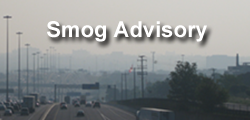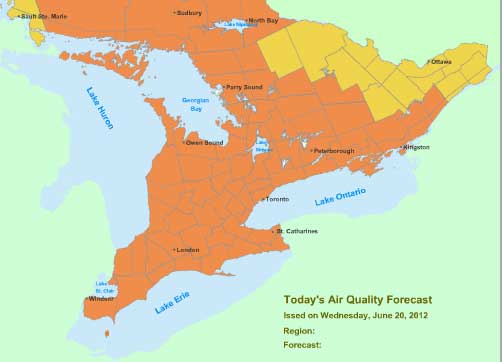
A SMOG ADVISORY* has been issued by the Ontario Ministry of the Environment for the following forecast regions for Wednesday, June 20, 2012:
- Bancroft-Bon Echo
- Barrie-Orillia-Midland
- Belleville-Quinte-Northumberland
- Brockville-Leeds and Grenville
- Burk’s Falls-Bayfield Inlet
- City of Hamilton
- City of Toronto
- Dufferin-Innisfil
- Dunnville-Caledonia-Haldimand
- Elgin
- Elliot Lake-Ranger Lake
- Greater Sudbury and Vicinity
- Grey-Bruce
- Haliburton
- Halton-Peel
- Huron-Perth
- Kingston-Prince Edward
- London-Middlesex
- Manitoulin-Northshore-Killarney
- Niagara
- North Bay-West Nipissing
- Oxford-Brant
- Parry Sound-Muskoka-Huntsville
- Peterborough-Kawartha Lakes
- Sarnia-Lambton
- Simcoe-Delhi-Norfolk
- Stirling-Tweed-South Frontenac
- Waterloo-Wellington
- Windsor-Essex-Chatham-Kent
- York-Durham

A smog advisory is in effect for Southern, Central, Mostly Northern & Parts of Eastern Ontario June 20, 2012.
- This advisory will remain in effect until further notice.
* A Smog Advisory means that there is a strong likelihood that there may be poor air quality within the next 24 hours due to ground-level ozone and/or particulate matter.
- It is an indicator of air quality, based on air pollutants that have adverse effects on human health and the environment.
- Smog is harmful to the lungs and heart.
- Even in healthy people, smog can reduce lung function.
- A Smog Advisory is related to the Air Quality Index (AQI), which rates how clean the air is.
- The AQI scale ranges from 0 to 100+.
- Higher numbers mean higher health risks.
- A Smog Advisory is issued in your region when the AQI is expected to reach 50 in the next 24 hours.
- It can be lifted once the AQI is expected to reach or drops below 50.
- Smog is made up of a complex mixture of air pollutants that are sometimes visible, such as a brownish-yellow haze over cities; sometimes not.
- The two main ingredients of smog are ground-level ozone (O3) and fine particulate matter (PM2.5).
Hot, sunny conditions, combined with a southwesterly flow of polluted air from the U.S. and local build-up of pollutants are resulting in elevated smog levels across southern, central, and parts of northern and eastern Ontario.
The details of the smog forecast are as follows:
- During Wednesday:
- A high pressure ridge over the eastern US is causing a southwesterly flow of warm and humid air over southern Ontario
- Mostly sunny skies and hot temperatures are forecasted over most of the forecast regions with southwesterly winds, except for some cloudiness over eastern and northwestern regions
- Air quality indices are forecasted to:
- increase to the poor category in the smog advisory regions, due to ozone
- be in the good to moderate categories elsewhere
- During Thursday:
- A cold front is forecasted to move eastward across northern Ontario during the morning, and over southern Ontario during the afternoon.
- The forecast expecations are:
- hot and humid conditions are forecast to continue over most regions with southwesterly winds during the morning ahead of the front
- followed by winds veering to west to northwesterly during the afternoon
- and increasing cloudiness is expected near the front
- Air quality indices are forecasted to:
- increase to the poor category in the smog advisory regions due to ozone
- be in the good to moderate categories elsewhere
- During Friday:
- The cold front is forecasted to be east of the province
- And a high pressure region is forecasted to be west of the Great Lakes
- Air quality indices are forecasted to be:
- in the good to moderate categories in southern and eastern Ontario
- generally in the good category elsewhere
During the smog episode, individuals may experience the following symptoms:
- eye irritation
- heavy outdoor exercise may cause respiratory symptoms such as coughing or shortness of breath
- people with heart or lung disease including asthma may experience a worsening of their condition
Please click here for details on air quality in Ontario.
Spare the Air Actions
During a smog advisory, there are a number of actions that you can take to help spare the air.
Travel tips – all year round:
- leave your car at home – walk, cycle, carpool or take public transit
- tele-conference instead of driving to meetings
- limit car trips by doing all your errands at once, and do not let your engine idle
- keep your car well tuned, check your tire pressure and drive at moderate speeds
Health tips:
- avoid exposure to vehicle exhaust fumes
- consult your doctor for specific health advice
- wear light clothing at work while air conditioning is reduced
- avoid strenuous exercise in the heat of the day
Electricity saving tips:
- save electricity at home by setting your air conditioner temperature a few degrees higher (health permitting) and
- turning off lights you are not using
Other pollution reduction tips:
- leave lawn mowing for another day
- restrict the use of gasoline-powered equipment
- delay using oil-based paints, solvents and cleaners
Please click on the following text to:
Please click here for more info about smog.
———————————
You may also want to know:
